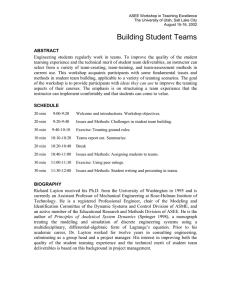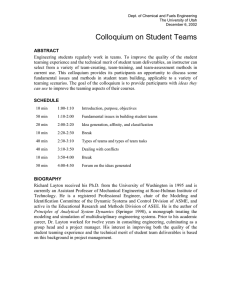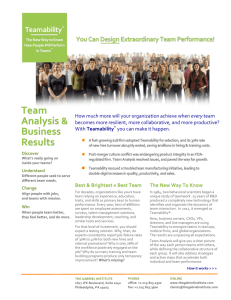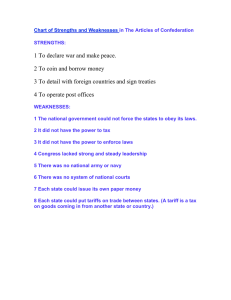How to Put Together Joint Ventures and Teaming Agreements
advertisement
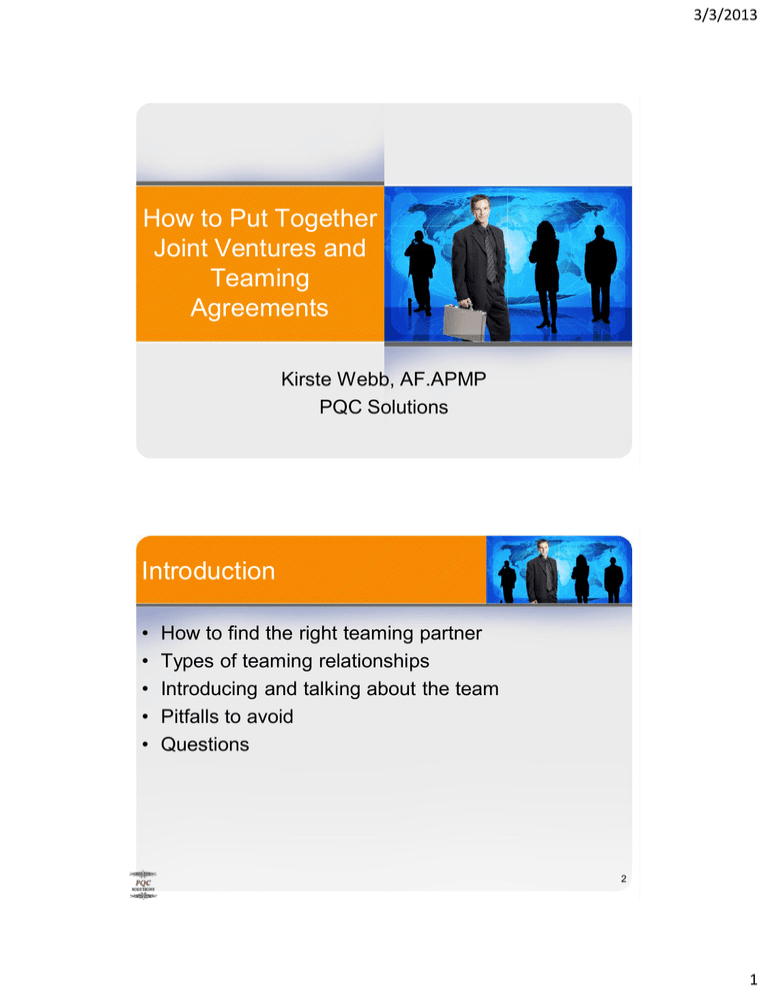
3/3/2013 How to Put Together Joint Ventures and Teaming Agreements Kirste Webb, AF.APMP PQC Solutions Introduction • • • • • How to find the right teaming partner Types of teaming relationships Introducing and talking about the team Pitfalls to avoid Questions 2 1 3/3/2013 How to Find the Right Teaming Partner • Like minded • Like hearted • Like philosophy 3 How Do I Win? • Define what it takes to win • Identify potential solution to be that winning team • Define teaming partners What does it take to win? Program manager with 15 years experience and direct experience working with the customer Designed and constructed 100,000 square foot Class A facilities in TN 4 2 3/3/2013 S – W – O – T Analysis • Strengths – Stronger than most competitors • W eaknesses – Gaps or performance issues • Opportunities – Competition’s areas of weaknesses that you have • Threats – Weaknesses that the competition will ghost 5 Strengths and Weaknesses • Be realistic and hard • Assess your team on its own merit, not comparing to your competitors • Identify actions to retain the strengths or to enhance your position • Identify actions to mitigate your weaknesses 6 3 3/3/2013 Opportunities and Threats • Opportunities – ghost your competition (point out their weaknesses while demonstrating your strengths) – How is your approach stronger, better, different… – What lessons learned have you applied • Threats – how your competition will ghost you and highlight your weaknesses – Recognize your gaps and – weaknesses – Talk to how you have – mitigated the weaknesses • Don’t be caught off-guard 7 What It Takes for You To Win What does it take to win? What do I need to do? Program manager with 15 years experience and direct experience working with the customer Bid Joe Johnson who has 20 years experience management similar programs and has worked with the customer for the past 5 years – outstanding references. Designed and constructed 100,000 square foot Class A facilities in TN Identify a team partner who brings this capability 8 4 3/3/2013 Identify Your Solution • Approach – What is it you offer – How do you offer it • What does the schedule look like – What are the performance goals and objectives • Organization – What does the program organization look like • Cost/Price – Lowest price or best value – How do you get to that price Define the risks and how you will manage or mitigate them! 9 Teaming Know Where Your Gaps Are • First step in understanding company’s ability to respond • Provides a good perspective of full scope for opportunity • Becomes the basis for “why this team” • Key components include: – – – – Scope Project requirements Personnel requirements Other client requirements (e.g., financial status) 10 5 3/3/2013 Teaming Developing the Gap Analysis • Scope requirements – – – – – Services Products Deliverables Performance measures Schedule • Project requirements – – – – Size, risk, complexity Contract type Scope Performance • Personnel requirements – – – – – Key positions Years experience Education Certifications/licenses Types of projects (see project requirements) • Other client requirements – Bonding – Project/personnel references – Subcontracting – Financials 11 Filling the Gaps • Identify companies with capabilities in the various areas • Consider other client requirements: – Key personnel have worked together – Companies have worked together – Key personnel have performed on the reference projects 12 6 3/3/2013 Filling the Gaps • Add in other concerns/issues: – Financial stability – Past performance issues – Willingness to team • Obtain proof to support analysis: – Dunn & Bradstreet reports – Federal government registration databases (e.g., Central Contractor Registration system or the U.S. Small Business Administration) 13 Filling the Gaps • Teaming considerations: – Have you worked with that company before? • Where and how was the performance rated? – Has that company worked with other companies on matrix before? • Where and how was the performance rated? – Has that company worked with this client before? • How was the performance rated? – Does that company want to team? 14 7 3/3/2013 Types of Teaming Relationships • Reasons for teaming – To respond to all SOW elements – Strengthen quality and quantity of personnel and corporate experience – Long-term strategic partnerships/alliances – Client requirements (may specify stand alone legal entity) • Types of teams: – Prime/sub – Joint venture or other newly formed legal entity 15 Determining Teaming Approach Prime/Sub Relationships • Approach – Integrated team – where subcontractor personnel are integrated into the organization – Designated subcontract – where subcontractor performs designated scope of work – Work best when prime meets most of the client requirements • Benefits – Single point of accountability – both corporate and personnel – Ability to control subcontractor performance • Issues – Potential to rely too heavily on a single subcontractor – may be perceived negatively by the client – Lack of accountability at subcontractor level 16 8 3/3/2013 Determining Teaming Approach Newly Formed Entity • Approach – Several forms: • Partnership • Joint Venture • Limited liability corporation – Required by some clients for larger, more complex projects • Benefits – Provides stand-alone entity for managing larger more complex projects – Allows for sharing of risk and reward among all partners • Issues – May be perceived as lacking single point of accountability 17 Introducing and Talking About the Team • Based on relationship • Address the reasons why the team joined forces (remember the gap analysis) • Draw from the best that both companies have to offer • Talk to past performance in terms of: – “Team member Company ABC…” – “Company XYZ, our team subcontractor for…” • Don’t hide behind the relationship – – Use it to your advantage – Ghost your competition by demonstrating your strengths 18 9 3/3/2013 Introducing and Talking About the Team • Past performance: – Acceptable for a procuring agency to consider the relevant experience and past performance of the individual joint venture members • For formal joint ventures: – Include documentation on joint venture – Obtain SBA approval, if required, BEFORE submission 19 Pitfalls to Avoid • Affiliation – one of the primary reasons for disqualifying a small business – Work with your SBA office – Have appropriate paperwork in place AND approved by SBA before submission – Clearly define roles and responsibilities – BEWARE of the ostensible subcontractor rule [13 CFR 121.103 (h)(4)] • Deemed affiliated if there is too much reliance on a single subcontractor 20 10 3/3/2013 Pitfalls to Avoid • Pricing – Fee structure – “fee on fee” and shared fee pools • Financials – Financial status – Bonding capacity – Payment terms • Roles and Responsibilities • Organization 21 QUESTIONS? 22 11
